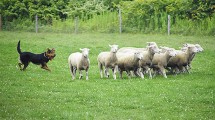Abstract
In this paper, we propose a method for efficiently guiding a large flock of sheep agents through the cooperation of multiple sheepdog agents even in the presence of anomalies, and verify its performance in computer experiments. In particular, this paper evaluates the proposed method extensively in addition to Tashiro et al., (Guidance by multiple sheepdogs including abnormalities. Swarm2021: The Fifth International Symposium on Swarm Behavior and Bio-Inspired Robotics, pp 1818–1823, 2022), and summarizes the effectiveness of the proposed method on six abnormal sheepdog herding systems based on three different anomalies, while changing the size of the herding systems.The results show that the proposed MSR algorithm (LeBlanc et al., IEEE J Select Areas Commun 31(4):766–781, 2013) can guide a group of sheep agents more efficiently and reliably than an efficient extension (Tashiro et al., Herd guidance by multiple sheepdogs. In: Swarm2021: The 4th International Symposium on Swarm Behavior and Bio-Inspired Robotics, 397–408, 2021; Kubo et al., Artif Life Robot 27(2):416–427, 2022) to multiple sheepdogs of the conventional single sheepdog method (Sueoka et al., Trans Jpn Soc Mech Eng Ser C 79(800):1046–1055), even when abnormal sheepdogs are included.

















Similar content being viewed by others
References
Tashiro M, Kubo M, Sato H, Yamaguchi A (2022) Guidance by multiple sheepdogs including abnormalities. In: Swarm2021: The Fifth International Symposium on Swarm Behavior and Bio-Inspired Robotics, pp 1818–1823
Tashiro M, Kubo M, Sato H (2021) Herd guidance by multiple sheepdogs. Swarm2021: The 4th International Symposium on Swarm Behavior and Bio-Inspired Robotics, pp 397–408
Kubo M, Tashiro M, Sato H, Yamaguchi A (2022) Herd guidance by multiple sheepdog agents with repulsive force. Artif Life Robot 27(2):416–427
Sueoka Y, Sugimoto Y, Nakanishi D, Ishikawa M, Osuka K, Ishiguro A (2013) Analysis of implicit control structure in object clustering by distributed autonomous robots. Trans Jpn Soc Mech Eng Ser C 79(800):1046–1055
Özdemir A, Gauci M Groß (2018) R orcid.org/0000-0003-1826-1375 Shepherding with robots that do not compute. In: ECAL 2017: The Fourteenth European Conference on Artificial Life. European Conference on Artificial Life, ECAL 2017, 04-08 Sep 2017, Lyon, France. MIT Press , Cambridge, MA , pp. 332-339. ISBN 9780262346337
LeBlanc HJ, Zhang H, Koutsoukos X, Sundaram S (2013) Resilient asymptotic consensus in robust networks. IEEE J Select Areas Commun 31(4):766–781
Long NK, Sammut K, Sgarioto D, Garratt M, Abbass HA (2020) A comprehensive review of shepherding as a bio-inspired Swarm-Robotics guidance approach. IEEE Trans Emerg Top Comput Intell 4(4):523–537. https://doi.org/10.1109/TETCI.2020.2992778
Yuichiro S, Yusuke T (2020) Multi-Agent System Control Motivated by Sheepdog System, Journal of The Society of Instrument and Control Engineers, 59, 2, p. 125-130, Online ISSN 1883-8170, Print ISSN 0453-4662. https://doi.org/10.11499/sicejl.59.125. https://www.jstage.jst.go.jp/article/sicejl/59/2/59_125/
Lien J-M, Rodr’iguez S, Malric J-P NM (2005) Amato: Shepherding behaviors with multiple shepherds. In: Proceedings of the 2005 IEEE International Conference on Robotics and Automation, pp. 3402-3407
Pierson A, Schwager M (2018) Controlling noncooperative herds with robotic herders. IEEE Trans Robot 34(2):517–525. https://doi.org/10.1109/TRO.2017.2776308
Lee W, Kim D (2017) Autonomous shepherding behaviors of multiple target steering robots. Sens (Basel, Switzerl) 17(12):2729. https://doi.org/10.3390/s17122729
Baxter D, Garratt M, Abbass HA (2021) Simulating Single and Multiple Sheepdogs Guidance of a Sheep Swarm. In: Abbass HA, Hunjet RA (eds) Shepherding UxVs for Human–Swarm teaming. Unmanned System Technologies. Springer, Cham. https://doi.org/10.1007/978-3-030-60898-9_3
Reynolds CW (1987) Flocks, herds and schools: a distributed behavioral model. ACM SIGGRAPH Comput Graph 21(4):25–34
Tsunoda Y, Sueoka Y, Wada T, Osuka K (2019) Theoretical analysis of mobile control method for group agents motivated by sheepdog shepherding. Trans Soc Instrum Control Eng 55(8):507–515
Ishii H (2016) Cyber-security in multi-agent consensus problems. J Soc Instrum Control Eng 55(11):936–941
Author information
Authors and Affiliations
Corresponding author
Additional information
Publisher's Note
Springer Nature remains neutral with regard to jurisdictional claims in published maps and institutional affiliations.
This work was presented in part at the joint symposium of the 27th International Symposium on Artificial Life and Robotics, the 7th International Symposium on BioComplexity, and the 5th International Symposium on Swarm Behavior and Bio-Inspired Robotics (Online, January 25–27, 2022).
About this article
Cite this article
Tashiro, M., Kubo, M., Sato, H. et al. Guidance by multiple sheepdogs including abnormalities. Artif Life Robotics 27, 714–725 (2022). https://doi.org/10.1007/s10015-022-00807-1
Received:
Accepted:
Published:
Issue Date:
DOI: https://doi.org/10.1007/s10015-022-00807-1




